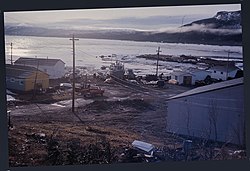Postville, Newfoundland and Labrador
Postville | |
|---|---|
Town | |
 Postville, early June 1977 | |
| Nickname(s): The Post | |
 Postville Location of Postville | |
| Coordinates: 54°54′37″N 59°48′08″W / 54.91028°N 59.80222°WCoordinates: 54°54′37″N 59°48′08″W / 54.91028°N 59.80222°W | |
| Country | Canada |
| Province | Newfoundland and Labrador |
| Region | Nunatsiavut |
| Government | |
| • Mayor (AngajukKâk) | Glen Sheppard |
| • Federal MP | Yvonne Jones (L) |
| • Provincial MHA | Lela Evans (PC) |
| • Nunatsiavut Assembly member | Tyler Edmunds (I) |
| Area | |
| • Total | 1.98 km2 (0.76 sq mi) |
| Elevation | 68 m (223 ft) |
| Population (2016)[1] | |
| • Total | 177 |
| • Density | 89.4/km2 (232/sq mi) |
| Time zone | UTC−04:00 (AST) |
| • Summer (DST) | UTC−03:00 (ADT) |
| Area code(s) | 709 |
Postville is an Inuit town in the north of Labrador, Canada.[2][3] It had a population of 177 as of 2016.[1] It is located about 40 km (25 mi) into the interior of Kaipokok Bay, 180 km (110 mi) NNE of Happy Valley-Goose Bay. Postville Airport is nearby.
Postville is inaccessible by road and may be reached only by air or sea.[4]
In the 18th century, the Franco-Canadian merchant Louis Fornel landed near the present site of Rigolet and claimed the land for France in 1743. The Franco-Canadians established trading posts in Kaipokok Bay at that time.
The English took control of the Labrador coast in 1763 after the Seven Years' War. This brought a flood of European fishermen and whalers to settle on the Labrador coast.[5]
Around 1784, Pierre Marcoux and Louis Marchand reopened the old Kaipokok trading post. In 1795, the Moravian Brothers of Hopedale observed that Pierre Marcoux and the former partner of George Cartwright Collingham were the first Europeans to settle in Kaipokok Bay.
In order to compete with the Moravians, the Hudson's Bay Company established a coastal trading post in Kaipokok Bay in 1837 shortly after Rigolet. The counter was operated until 1878.
The village was first known as The Post because of the Hudson's Bay Company trading post located in the area. Inuit families traded in the fall, winter and spring before returning to the coastal camps in the summer. The village was renamed Postville in the 1940s by a pastor who helped establish the community by building a school and a church.[6]
References[]
- ^ Jump up to: a b c "Postville, Town [Census subdivision], Newfoundland and Labrador and Division No. 11, Census division [Census division], Newfoundland and Labrador". www12.statcan.gc.ca. Government of Canada. Retrieved April 1, 2020.
- ^ "Labrador Inuit land claim passes last hurdle". CBC News. June 24, 2005. Archived from the original on March 21, 2007. Retrieved April 22, 2010.
- ^ "Inuit celebrate self-government turnover". CBC News. December 1, 2005. Archived from the original on March 16, 2007. Retrieved April 22, 2010.
- ^ Churchill Duke, Laura (20 Sep 2019). "Hopedale woman circulating petition calling for the province to subsidize flights to northern Labrador". Saltwire. Retrieved 23 July 2021.
- ^ "Social Studies Curriculum Guide 2010, Ch.3" (PDF). Government of Newfoundland and Labrador. Retrieved 23 Jul 2021.
- ^ "Postville". Tourism Nunasiavut. Retrieved 23 Jul 2021.
- Inuit community governments in Newfoundland and Labrador
- Populated places in Labrador
- Road-inaccessible communities of Newfoundland and Labrador
- Labrador geography stubs
